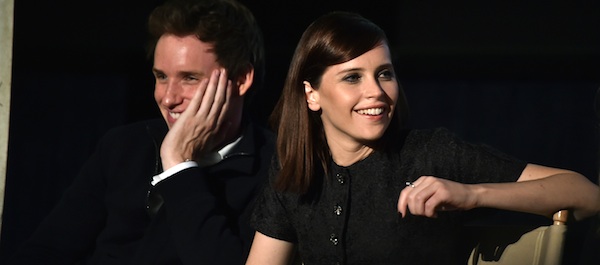The Fine Art of Movie Science in The Theory of Everything

The 2014 Sloan Film Summit, hosted by Film Independent and the Alfred P. Sloan Foundation, took place November 14–16 in downtown Los Angeles and celebrated the intersection of science and the art of storytelling. The Summit opened that Friday night with a public screening of The Theory of Everything, James Marsh’s Stephen Hawking biopic starring Eddie Redmayne and Felicity Jones (and Film Independent hosted another screening of the film last night, followed by a conversation with Marsh). Following the Summit screening, Redmayne—who had won the Hollywood Film Award for Breakout Performance Actor just hours before—and Jones, along with producer Lisa Bruce and Professor of Physics David Kaplan, did a Q&A moderated by The Hollywood Reporter’s Carolyn Giardina.
Redmayne stars as Hawking and Jones as his first wife, Jane (the screenplay was adapted by Anthony McCarten from Jane Hawking’s memoir, Travelling to Infinity: My Life with Stephen). The film begins when the two of them meet as students at Cambridge in 1963, and soon after, 21-year-old Stephen is diagnosed with motor neurone disease. The doctor predicts he has two years to live, but Jane wants to marry him anyway. The film chronicles their life together as their romance evolves over decades, all while Stephen rapidly loses control of his own body—but retains his brilliant mind.
There’s one scene in the film in which young Stephen, working on his master’s thesis at Cambridge, furiously writes highly sophisticated equations on a chalkboard. Redmayne, who studied art history and gave up science class when he was 14, felt rather out of his element with the physics, but approached his enactment of the scene as an artist. “The idea of science being creative is really interesting to me,” he said. “I’m a useless painter, but I occasionally do paint, and that idea of when you’re looking at a canvas and you’re going, ‘What does it need? Where does it need a bit of something?’—that was how I tried to approach it.” (They were, in fact, real equations written on the board—Redmayne memorized but admitted he did not understand them.) Bruce agreed with him: “Science, for me, was much more linear before this, in my prejudice of it,” she said. “That ‘oh, the creative is over here and science is over here; it’s like math.’ And I just experience it all totally differently now.”
Jones said what she took away from the experience is that “Stephen [was] given two years to live, and now he’s in his 70s… There are no rules about anything, and I guess that’s the same with science. I guess that’s part of what science is—breaking rules constantly and finding something new.” Hawking is definitely a rule-breaker, and Kaplan said one of the things he liked about the film was that it portrayed Hawking as a scientist who can “rigorously prove things…but can also speculate wildly”—a quality Kaplan believes characterizes our best scientists.
Speaking on behalf the audience, which consisted primarily of non-physicists, Giardino asked Kaplan what this kind of science means for the rest of us. “You get that question all the time—Do we get faster computers? Are we going to cure something?” Kaplan said, “and all of that research that does all those things is very important, but there’s a type of physics and research that’s just pure, basic understanding of what reality is… We are trying to figure out what this all is, and in what context we live.” And isn’t that a function of art as well? Don’t we create and engage with art in an effort to make sense of and giving meaning to the world around us?
“You can ask any single human being, ‘what do you do to survive, and what do you do to thrive, and then, what inspires you—what do you aspire to?’” Kaplan said, “and I like to think of this type of research as something that the human race is aspiring to.”
The film might have been a wonderful love story, but all the science talk had to be the most romantic thing I heard all night.
Mary Sollosi / Film Independent Blogger
